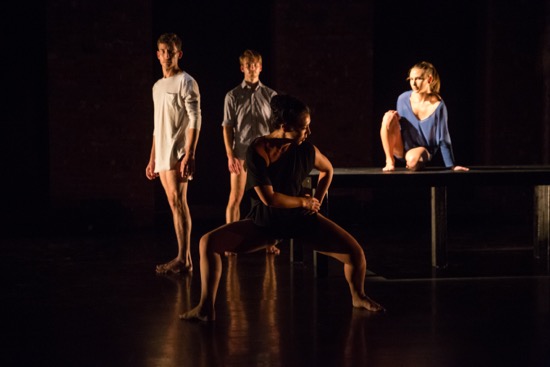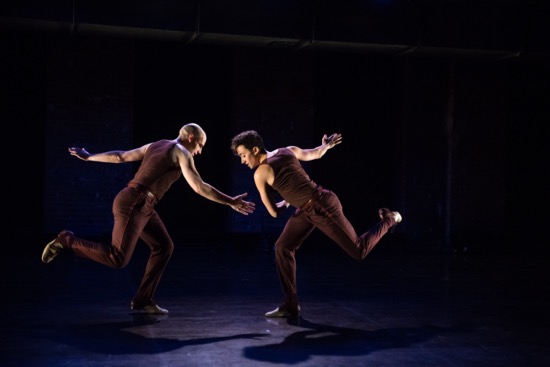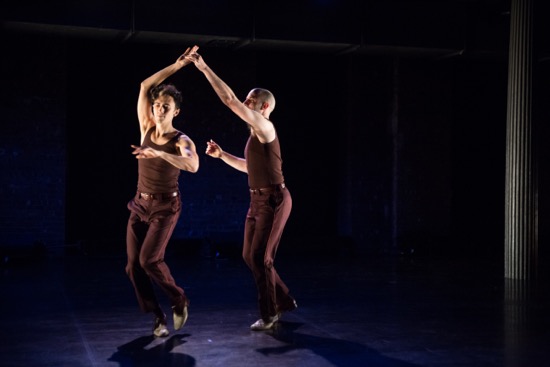Dylan Crossman Dans(c)e shares a program with Caleb Teicher & Company at Gibney Dance: Agnes Varis Performing Arts Center.
![Dylan Crossman's [Insert Title]. (L to R): Crossman (on table), Sumi Clements, Jason Collins, and Sarah Haarmann. Photo: Scott Shaw](https://www.artsjournal.com/dancebeat/wp-content/uploads/2016/12/DylanCrossmanDansce-byScottShaw-13.jpg)
Dylan Crossman’s [Insert Title]. (L to R): Crossman (on table), Sumi Clements, Jason Collins, and Sarah Haarmann. Photo: Scott Shaw
One of the striking things about Crossman’s [Insert Title] is indeed the ways in which the four members of Dylan Crossman Dans(c)e interact and especially how they regard one another. They begin standing in a row at one end of the brick-walled performance space: Sumi Clements, Jason Collins, Sarah Haarmann, and Crossman. The space before them is still dark, and Jesse Stiles’s sound design is still silent. Soon that space will become a darkly glowing place or one of almost blinding light (lighting design by Asami Morita, after Scott Nelson’s original). Soon we will hear abrasive sounds, as of sandpaper on wood, muted voices talking quietly in an unknown tongue (actually, I’m guessing, English run backward until just before the end), and other electronic surgings.

(L to R): Dylan Crossman, Jason Collins, Sumi Clements, and Sarah Haartmann in Crossman’s [No Title]. Photo: Scott Shaw
All this time you wonder what could be happening to these people, with their individual explosions of dancing and their concerns for one another. Later, I think of depictions of “The Last Supper,” with the disciples leaning toward and away from their colleagues as if exchanging urgent questions. Or Sartre’s No Exit. Later still, I think of Anne Frank. Crossman’s no-title title and the choreography itself encourage us to fill in the blanks and invent our own stories. Or not.
In the end, Crossman stares at Clements while Haarmann and Collins dance in a big, generous way, stop, and then retreat together. Then Clements looks Crossman and then toward the end of the room where the others have gone. He leaves in the opposite direction. Sitting on the table, she waits for whatever is to come.

Nathan Bugh (L) and Caleb Teicher in their Meet Ella. Photo: Scott Shaw
There’s no such subtle drama going on between Bugh and Teicher of Caleb Teicher & Company in Meet Ella, a part-choreographed, part-improvised duet on which they collaborated. They’re admiring colleagues, dance partners, and easy-going rivals. However, like the performers in Crossman’s work, each keeps his eye on the other.
The “Ella” of the title is, of course, Ella Fitzgerald, and the musical selections are taken from recordings of her concerts in Rome (1958) and Berlin (1950). How wondrously she purrs and scats and growls and nurses the melodious words of cherished songs, such as “That Old Black Magic,” “Smoke Gets in Your Eyes,” “I Can’t Give You Anything but Love,” “How High the Moon,” and more. And since this is a soft-shoe adventure, we hear the music clearly.
The two men enact their camaraderie with relaxed charm. Even though they sometimes dance in unison, their personal styles differ. Teicher is slim and sleek, and his dancing is clear-cut—that is, within the loose, getting-down approach that the music and the style(s) ask for. Bugh is more hunkered down and looser still, and his head and arms have their own unplanned little dances. Both have mobile hips, can slam into a semi-split, kick up their legs as if a cakewalk is imminent; one can flip the other into the air; each can jump over his own leg, and, of course, both can inveigle the floor to collaborate with the rhythmic intricacies they’re stamping into it.

Caleb Teicher (L) and Nathan Bugh in their Meet Ella. Photo: Scott Shaw
There’s no credit for lighting in the program, but it avoids flashiness, while providing such imaginative effects as pools of light in time with drum gunshots in the music. Meet Ella as a whole has a relaxed dynamic; slow or still moments to rest or plan, steady hoofing, and sudden virtuosic bursts. Bugh is a swing-dance champion, and the two men periodically return to a ballroom-dance hold and some basic turning and stepping. The device reinforces their friendship (although, to my mind, they resort to it a bit too often).
I like seeing this mostly unshowy, smart-guys-having-a good-time time way of presenting jazz dancing. Of course, they want us to love and admire their skills (and we do) but they don’t urge that on us.
Still to come in the DoublePlus series: Oren Barnoy + Naomi Elena Ramirez, curated by Luciana Achugar (12/8-12/10) and Leslie Cuyjet + Lela Aisha Jones, curated by Cynthia Oliver (12/15-12/17).
